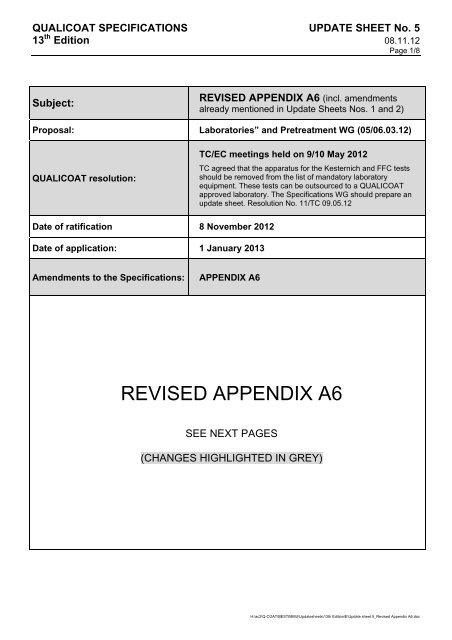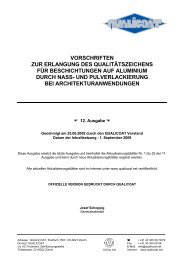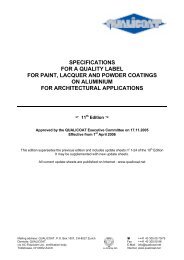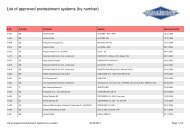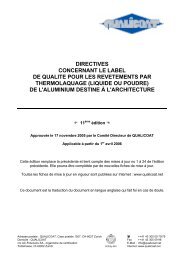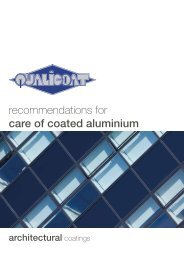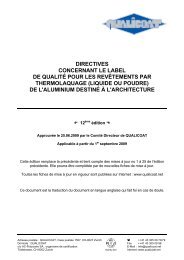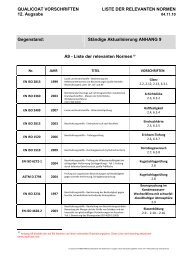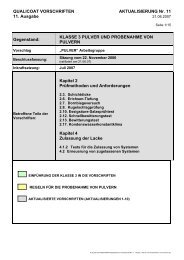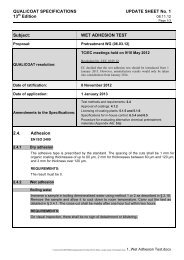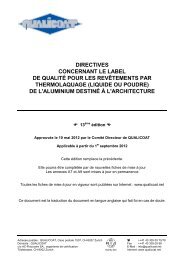UPDATE SHEET No 5 (DRAFT) - Qualicoat
UPDATE SHEET No 5 (DRAFT) - Qualicoat
UPDATE SHEET No 5 (DRAFT) - Qualicoat
Create successful ePaper yourself
Turn your PDF publications into a flip-book with our unique Google optimized e-Paper software.
QUALICOAT SPECIFICATIONS <strong>UPDATE</strong> <strong>SHEET</strong> <strong>No</strong>. 513 th Edition 08.11.12Page 1/8Subject:REVISED APPENDIX A6 (incl. amendmentsalready mentioned in Update Sheets <strong>No</strong>s. 1 and 2)Proposal: Laboratories” and Pretreatment WG (05/06.03.12)QUALICOAT resolution:TC/EC meetings held on 9/10 May 2012TC agreed that the apparatus for the Kesternich and FFC testsshould be removed from the list of mandatory laboratoryequipment. These tests can be outsourced to a QUALICOATapproved laboratory. The Specifications WG should prepare anupdate sheet. Resolution <strong>No</strong>. 11/TC 09.05.12Date of ratification 8 <strong>No</strong>vember 2012Date of application: 1 January 2013Amendments to the Specifications:APPENDIX A6REVISED APPENDIX A6SEE NEXT PAGES(CHANGES HIGHLIGHTED IN GREY)H:\ac2\Q-COAT\BESTIMMU\Updatesheets\13th Edition\E\Update sheet 5_Revised Appendix A6.doc
QUALICOAT SPECIFICATIONS <strong>UPDATE</strong> <strong>SHEET</strong> <strong>No</strong>. 513 th Edition 08.11.12Page 2/8A6 – Procedure for evaluating alternative chemical pretreatment materials1. INTRODUCTIONThis Appendix specifies the procedure for granting and renewing an approval for alternativepretreatment systems. It also describes the testing programme to be followed by thelaboratories involved and the requirements for every test.2. FORMAL APPLICATION PRIOR TO TESTINGChemical manufacturers who plan to submit a new alternative pretreatment system for testingshall send a formal request to the General Licensee or to QUALICOAT in countries without anational association.If the pretreatment system is manufactured at several production plants, the applicant shallname the main production site and/or technical service centre and indicate all other productionsites.Basic documentation (TDS), a safety data sheet and detailed instructions on treatment cyclesshall be submitted to an approved QUALICOAT laboratory selected in agreement with theGeneral Licensee and/or QUALICOAT.The following minimum technical information shall also be provided to the QUALICOATlaboratory in charge on a separate sheet (General Technical Information):APPLICATION METHOD (1) (2)PROCESS CYCLE (2)FINAL RINSEANALYTICAL METHODS FOR BATHFILM WEIGHT (3)OTHER ANALYSESOTHER RECOMMENDATIONS (EQUIPMENT, HANDLING,STORAGE ETC.) (4)COLOURLESS CONVERSION COATING?DRYING CONDITIONS(1) Spraying and/or immersion.(2) The manufacturer is responsible for ensuring that the cycle used by the coating applicator is suitable for obtaining acoated product conforming to the QUALICOAT Specifications. What are the limits for demineralised water beforeconversion coating?(3) Method for in‐house control and laboratory tests (limits and frequency).(4) The technical specifications shall make it clear which items are compulsory, for instance does “recommended” meancompulsory or not?H:\ac2\Q-COAT\BESTIMMU\Updatesheets\13th Edition\E\Update sheet 5_Revised Appendix A6.doc
QUALICOAT SPECIFICATIONS <strong>UPDATE</strong> <strong>SHEET</strong> <strong>No</strong>. 513 th Edition 08.11.12Page 3/83. PRELIMINARY CONDITIONS (MINIMUM EQUIPMENT)The chemical manufacturer shall have the following minimum equipment available at atleast one location (main production site and/or technical service centre):• analytical instruments for testing the quality of the conversion coating;• cutting tools and instruments necessary for performing the adhesion test;• apparatus for testing adhesion and elasticity (cupping test);• impact tester (EN ISO 6272);• apparatus for testing resistance to cracking on bending;• apparatus to carry out the following corrosion tests:o constant climate condensation watero resistance to humid atmospheres containing sulphur dioxide 11o acetic acid salt spray resistanceo pressure cooker testo filiform corrosion test 111At all other locations (not being the main production site and/or technical service centre),the following requirements shall be met:• A method for testing the quality of the conversion coating shall be available.• Tests that cannot be carried out on‐site shall be performed by the laboratory at the mainproduction site and/or technical service centre or outsourced to any QUALICOATapproved laboratory.4. QUALICOAT TESTING LABORATORIESBefore an approval is granted for a new pretreatment system, the laboratory in charge shall carryout the testing programme specified in the following section. Corrosion tests shall also beperformed by a second laboratory under the responsibility of the laboratory in charge.For renewal of an approval, the full testing programme shall be carried out only by thelaboratory in charge.5. TESTING PROGRAMMEApproval is based on the following testing programme to ensure conformity with therequirements prescribed by QUALICOAT.a) PANEL PREPARATIONFor every corrosion test, six extruded samples shall be evaluated (three samples in each ofthe two laboratories involved).111 These tests may be outsourced and carried out by a QUALICOAT approved laboratory or another laboratory accredited forthese specific tests according to ISO 17025.H:\ac2\Q-COAT\BESTIMMU\Updatesheets\13th Edition\E\Update sheet 5_Revised Appendix A6.doc
QUALICOAT SPECIFICATIONS <strong>UPDATE</strong> <strong>SHEET</strong> <strong>No</strong>. 513 th Edition 08.11.12Page 4/8Special attention shall be paid to the preparation of samples. The final results of corrosionand exposure tests depend not only on the treatment but also on the aluminiumcomposition and the reaction between the aluminium surface and chemical products.The manufacturers shall indicate the complete pretreatment cycle to be used (degreasingetc.), and the laboratory responsible for preparing the samples shall strictly follow theseinstructions.The samples may be prepared:• either in the QUALICOAT approved laboratory under the supervision of a representativeof the applicant company;• or in the laboratory of the chemical manufacturer under the supervision of arepresentative of the laboratory in charge.SamplesThe following alloys shall be used:• panels for mechanical tests (thickness of 0.8 or 1 mm): AA 5005‐H24 or ‐H14 (AlMg 1 ‐semihard);• extruded samples for corrosion tests and outdoor exposure: AA 6060 or 6063.The chemical composition of the samples has an influence on the final results, especially incorrosion tests. For this reason, all laboratories shall use an alloy from the same batch toprepare the samples.QUALICOAT shall provide every laboratory with enough test samples having a chemicalcomposition specified by the Technical Committee.The laboratory’s final report shall always indicate the chemical composition.PretreatmentThe laboratory in charge of preparing the samples shall take into account the followingparameters:• Etching degreeThe total etching degree shall be between 1.0 g/m 2 and 2.0 g/m 2 on samples for all tests.• Weight of the conversion coatingo close to the system’s lower limit for corrosion test samples;o close to the upper limit for mechanical test samples, especially for the adhesion test.Coating material to be appliedThe coating system material shall have a QUALICOAT approval.Each system shall be tested with the following organic coating materials:• class 1 powder, metallic colour (RAL 9006 or RAL 9007)• class 2 powder, category 1, RAL 9010• class 3 powder (when requested by the supplier).• liquid coating (when requested by the supplier)H:\ac2\Q-COAT\BESTIMMU\Updatesheets\13th Edition\E\Update sheet 5_Revised Appendix A6.doc
QUALICOAT SPECIFICATIONS <strong>UPDATE</strong> <strong>SHEET</strong> <strong>No</strong>. 513 th Edition 08.11.12Page 5/8b) LABORATORY TESTSThe following tests shall be performed:• Mechanical tests (according to the QUALICOAT Specifications)• impact• dry adhesion and wet adhesion• bend• cupping.• Corrosion tests (according to the QUALICOAT Specifications)• constant climate condensation water• resistance to humid atmospheres containing sulphur dioxide• acetic acid salt spray resistance• pressure cooker• filiform corrosionThe acceptable limits are the same as those prescribed in the QUALICOAT Specifications.Evaluation of laboratory test resultsThe final evaluation shall be as follows:• Result of one laboratoryPOSITIVENEGATIVE0 or 1 unsatisfactory panel2 or more unsatisfactory panels.• Results of two laboratories‣ If the results in both laboratories are positive, the system is satisfactory.‣ If the results in both laboratories are negative, the system is unsatisfactory.‣ If the results are positive in one laboratory and negative in the other, the tests shall berepeated in a third laboratory.c) OUTDOOR EXPOSURE• Exposure site2 years in Genoa starting in September.• Number of panelsAll tests shall be made in triplicate.Fig. 1 Scratches for outdoor exposure(panel dimensions: length 200 mm, width 70 – 100 mm)At least 1 mm wide.The panels must bescored down to the metal.10 mmH:\ac2\Q-COAT\BESTIMMU\Updatesheets\13th Edition\E\Update sheet 5_Revised Appendix A6.doc
QUALICOAT SPECIFICATIONS <strong>UPDATE</strong> <strong>SHEET</strong> <strong>No</strong>. 513 th Edition 08.11.12Page 6/8Evaluation of exposure test resultsAfter 2 years of exposure, a final evaluation shall be made, applying the following criteria:POSITIVE 0 or 1 unsatisfactory panelNEGATIVE6. CONFORMITY ASSESSMENT2 or more unsatisfactory panelsA QUALICOAT working group shall evaluate the laboratories’ test results and take a decision, alsoin writing.If necessary, the chemical manufacturer of the system tested shall be invited to a meeting todiscuss the results.7. GRANTING OF AN APPROVALIf all the results meet the requirements, QUALICOAT shall issue an approval number and acertificate signed by the President, which is valid for three years.After the exposure tests, the working group shall evaluate the results and take a decision onconfirmation of the approval. The manufacturer shall be informed of the results and decisions.8. RENEWAL OF PRETREATMENT SYSTEM APPROVALSApprovals shall be renewed every three years, with the full testing programme including outdoorexposure (see § 5 of this Appendix) carried out by one laboratory. Once a system has beenapproved for six consecutive years, the renewal interval shall be extended to five years.If an approved system identified by a single approval number is manufactured at differentproduction sites of the same company, the full testing programme (including the exposure test)shall be carried out for the main production site and/or technical service centre. At the otherproduction sites indicated by the chemical manufacturer, the approved pretreatment systemshall be checked only with corrosion tests.An approval shall be renewed if the results of the laboratory and exposure tests conform to theSpecifications.If the laboratory test results are negative, all corrosion tests shall be repeated in twolaboratories. Renewal shall be confirmed if the results are positive in both laboratories. If theresults are negative in one of the two laboratories, the approval shall be cancelled. If the resultof outdoor exposure is negative, the approval shall then be cancelled.9. RESPONSIBILITYa) MANUFACTURER’S RESPONSIBILITYThe coating applicator is expected to use the products as instructed by his supplier. Themanufacturers shall be responsible for all cycles used by coating applicators.H:\ac2\Q-COAT\BESTIMMU\Updatesheets\13th Edition\E\Update sheet 5_Revised Appendix A6.doc
QUALICOAT SPECIFICATIONS <strong>UPDATE</strong> <strong>SHEET</strong> <strong>No</strong>. 513 th Edition 08.11.12Page 7/8Manufacturers and customers (coating applicators) already cooperate closely. For allsystems, there shall be technical data sheets, also giving information about other productswith which a system may or may not be used. System manufacturers shall send QUALICOATa valid technical data sheet.To take into account the particular conditions in each plant, the system manufacturer shallalso provide specific instructions to be followed by the persons in charge of the plant. Theseinstructions or requirements shall be consistent with the general technical data sheets. TheQUALICOAT inspector may request these instructions to ensure that the coating applicator isusing the correct method.The manufacturer shall indicate how the quality of the chromium‐free conversion coatingshould be monitored during in‐house control. The methods for assessing the conversioncoating may differ from one system to the next since there is not a pertinent standard.QUALICOAT shall send these data sheets to the General Licensees (national associations) andrecognised testing laboratories.These tests shall be performed with the following frequency:• practical method in the coating plant: daily/shift• analytical method in the manufacturer’s facilities: once every two weeks.The results shall be entered and retained in records readily accessible to the inspector.Cooperation between the coating applicator and chemical manufacturer:Every two months, the chemical manufacturer shall carry out the following tests on threeproduction samples:• acetic acid salt spray resistance• wet adhesion testIf the results are unsatisfactory, the chemical manufacturer shall seek the causes and advisecorrective action.Details shall be entered and retained in records readily accessible to the inspector in theplant and in the chemical manufacturer’s facilities.b) COATING APPLICATOR’S RESPONSIBILITYThe coating applicator shall be responsible for the quality of the coated products. Only theuser is able to control all the parameters in his plant. However, the manufacturers shall beprepared to check more frequently whether their customers adhere to the specificationsstipulated on the technical data sheets. During their regular visits, they shall also verify thevalues recorded by the licensed plants during their in‐house control.H:\ac2\Q-COAT\BESTIMMU\Updatesheets\13th Edition\E\Update sheet 5_Revised Appendix A6.doc
QUALICOAT SPECIFICATIONS <strong>UPDATE</strong> <strong>SHEET</strong> <strong>No</strong>. 513 th Edition 08.11.12Page 8/810. COMPULSORY DECLARATION OF CHANGES IN FORMULATION OF ALTERNATIVEPRETREATMENTSIn principle, if the chemical composition of the conversion coating remains the same, it shall notbe necessary to apply for a new approval. In practice, this means accepting all the variationsspecified on the technical data sheet to adjust the system to a specific application line in order toachieve the specified coating weight. The chemical product may be supplied as a two‐componentor single‐component system. The chemical manufacturers shall guarantee that the chemicalcomposition of the working solution is essentially the same as that approved by QUALICOAT.Any change in formula that can result in significant changes in the composition of the conversioncoating represents a new product and requires a new QUALICOAT approval.To give a few examples of such changes, we would like to mention some clear‐cut cases:• Any change in the metal content of the coating through substitution, addition, removal, etc. ofthe approved metal system when the products are based on transition metals replacingchrome.• Any change in the polymer composition and, by extension, in the organic components throughsubstitution, addition, removal etc. when they are present in the approved formula.• Any change in the typical appearance of the conversion coating, for example from colourless tocolour.H:\ac2\Q-COAT\BESTIMMU\Updatesheets\13th Edition\E\Update sheet 5_Revised Appendix A6.doc


